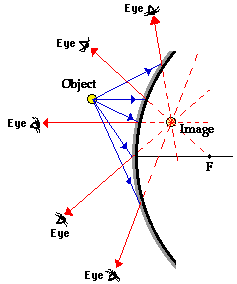Saturday, August 4, 2007
CONVEX MIRRORSThe image formed by a convex mirror is virtual, upright, and smaller than the object. This is illustrated by the ray diagram below. The diagram depicts the three rays that are discussed in the following paragraph. A ray (1) parallel to the optical axis is reflected as if it came from the focal point (f). A ray (2) directed toward the focal point is reflected parallel to the optical axis. A ray (3) striking the mirror at the optical axis is reflected at an angle equal to the angle of incidence.









